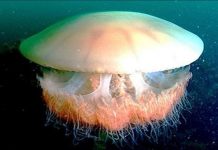Oct. 24 (UPI) — When researchers drilled into the Arctic sea and plunged a camera into the Chukchi Sea, they were surprised to find adult Chrysaora melanaster jellyfish floating by.
Until now, scientists assumed jellyfish only survived the winter in the form of polyps, small masses that bind to rocks and release tiny baby jellyfish each spring.
Scientists detailed their collection of underwater videos in a new paper on the Arctic jellyfish, published this week in the journal Marine Ecology Progress Series.
“One reason we were interested was, first of all, we saw them, and it was kind of weird,” Andy Juhl, a marine biologist at Columbia University’s Lamont-Doherty Earth Observatory, said in a news release.
Studying marine relief in the Chukchi Sea during the harsh Arctic winters isn’t easy. For the past several years, Juhl and his colleagues have snowmobiled several miles across the sea ice and drilled a hole through which they deploy a small underwater vehicle equipped with a camera.
“The whole study is based on videos we made over several years,” Juhl said.
The footage features the animals’ foot-long-plus tentacles, but Juhl isn’t sure whether the tentacles sting.
“I don’t know,” he said. “There aren’t that many people around there swimming to find out.”
The videos’ content may explain why commercial pollock fishermen in the nearby Bering Sea often find their nets fouled by a barrage of jellyfish. Pollock is used to make fish sticks, fish patties, imitation crab meat and other fish products.
Every few years, the jellyfish population seems to peak, clogging fishing rigs. The problem tends to crescendo and dissipate, and scientists suggest their research may help explain the factors driving these population cycles.
As to why the jellyfish are congregating beneath Arctic sea ice, scientists hypothesize that the icy ceiling shelters the creatures from strong winter storms and that the colder water temperatures slow their metabolism, helping them subsist off smaller amounts of food.
“Life under sea ice is like living in a refrigerator — everything slows down,” Juhl said.
Elsewhere, warming water temperatures are allowing select species of resilient jellyfish to dominate ecosystems, but shrinking sea ice in the Arctic could see Chrysaora melanaster dwindle.





